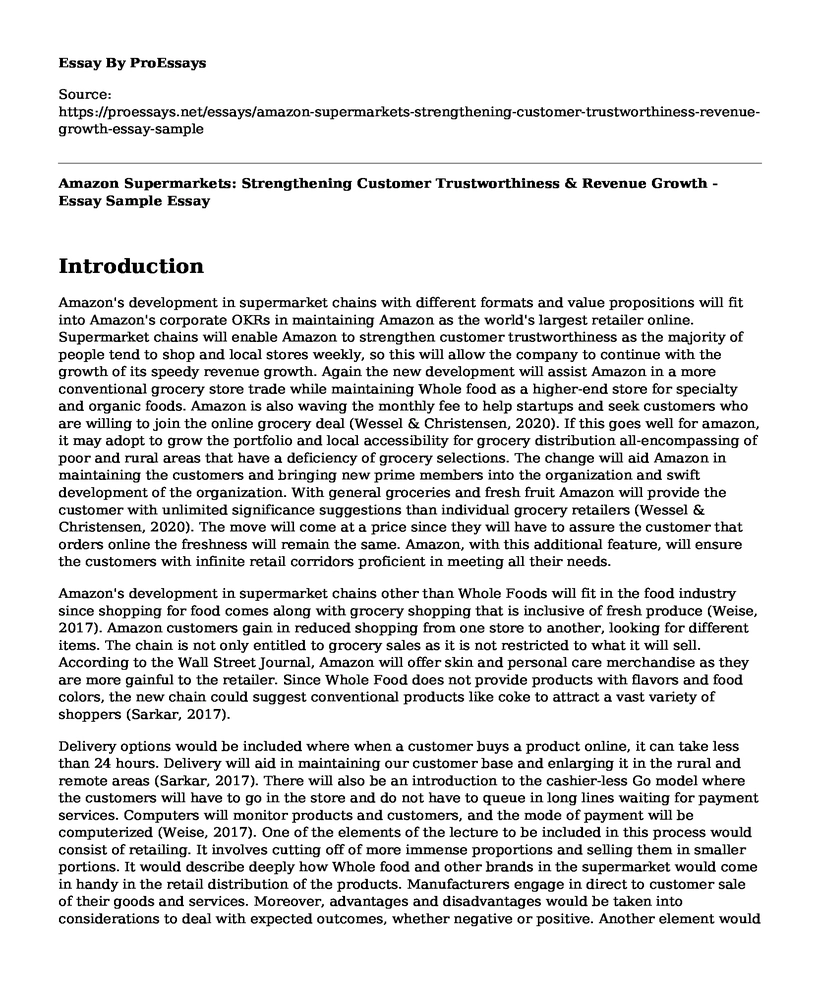Introduction
Amazon's development in supermarket chains with different formats and value propositions will fit into Amazon's corporate OKRs in maintaining Amazon as the world's largest retailer online. Supermarket chains will enable Amazon to strengthen customer trustworthiness as the majority of people tend to shop and local stores weekly, so this will allow the company to continue with the growth of its speedy revenue growth. Again the new development will assist Amazon in a more conventional grocery store trade while maintaining Whole food as a higher-end store for specialty and organic foods. Amazon is also waving the monthly fee to help startups and seek customers who are willing to join the online grocery deal (Wessel & Christensen, 2020). If this goes well for amazon, it may adopt to grow the portfolio and local accessibility for grocery distribution all-encompassing of poor and rural areas that have a deficiency of grocery selections. The change will aid Amazon in maintaining the customers and bringing new prime members into the organization and swift development of the organization. With general groceries and fresh fruit Amazon will provide the customer with unlimited significance suggestions than individual grocery retailers (Wessel & Christensen, 2020). The move will come at a price since they will have to assure the customer that orders online the freshness will remain the same. Amazon, with this additional feature, will ensure the customers with infinite retail corridors proficient in meeting all their needs.
Amazon's development in supermarket chains other than Whole Foods will fit in the food industry since shopping for food comes along with grocery shopping that is inclusive of fresh produce (Weise, 2017). Amazon customers gain in reduced shopping from one store to another, looking for different items. The chain is not only entitled to grocery sales as it is not restricted to what it will sell. According to the Wall Street Journal, Amazon will offer skin and personal care merchandise as they are more gainful to the retailer. Since Whole Food does not provide products with flavors and food colors, the new chain could suggest conventional products like coke to attract a vast variety of shoppers (Sarkar, 2017).
Delivery options would be included where when a customer buys a product online, it can take less than 24 hours. Delivery will aid in maintaining our customer base and enlarging it in the rural and remote areas (Sarkar, 2017). There will also be an introduction to the cashier-less Go model where the customers will have to go in the store and do not have to queue in long lines waiting for payment services. Computers will monitor products and customers, and the mode of payment will be computerized (Weise, 2017). One of the elements of the lecture to be included in this process would consist of retailing. It involves cutting off of more immense proportions and selling them in smaller portions. It would describe deeply how Whole food and other brands in the supermarket would come in handy in the retail distribution of the products. Manufacturers engage in direct to customer sale of their goods and services. Moreover, advantages and disadvantages would be taken into considerations to deal with expected outcomes, whether negative or positive. Another element would be barriers to the effective establishment of the chain which would entail competition from existing firms that provide the services the firm is indulging in. The marketing of the store would be included. Marketing strategies to make the store known more to customers would assist the chain in making its product known to customers (Sarkar, 2017). Strategies on how to sell the products would be a significant element to be included. The plan would entail overcoming the competition and the position of where to locate the chain (Wessel & Christensen, 2020). Lastly, environmental considerations would be included. These include the political environment, technological environment, economic environment, social, cultural environment, demographic environment, and social environment. All these considerations taken into place Amazon will reign in opening the supermarket chain with a brand other than Whole Foods.
References
Sarkar, C. (2017). "Amazon's Strategy Whiteboard: Whole Foods Acquisition Disrupts Retail." The Marketing Journal. Retrieved from https://www.marketingjournal.org/amazons-strategy-whiteboard-whole-foods-acquisition-disrupts-the-grocery-business-model/
Weise, K. (2017). Amazon wants to rule the grocery aisles, and not just at whole foods. The New York Times. Retrieved from https://www.nytimes.com/2019/07/28/technology/whole-foods-amazon-grocery.html
Wessel, M., & Christensen, C. (2020). Surviving disruption. Harvard Business Review. Retrieved from https://hbr.org/2012/12/surviving-disruption
Cite this page
Amazon Supermarkets: Strengthening Customer Trustworthiness & Revenue Growth - Essay Sample. (2023, Apr 22). Retrieved from https://proessays.net/essays/amazon-supermarkets-strengthening-customer-trustworthiness-revenue-growth-essay-sample
If you are the original author of this essay and no longer wish to have it published on the ProEssays website, please click below to request its removal:
- Management Essay Sample. William Henry Gates: Leadership in Microsoft
- Merchandising Operations and Inventory in Walmart Inc Essay
- Essay Sample on Apple Inc. Customer Analysis
- Coca-Cola, NASDAQ, Morningstar Inc.: Global Success Stories - Essay Sample
- Apple: A Leader in Technology and Innovation - Essay Sample
- Essay Example on Jane and John: Conflict in Apple's Finance Department
- Essay Sample on Amazon Withdraws from Chinese Market after 16 Years of Struggle







